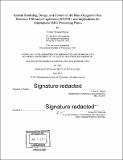System modeling, design, and control of the Mars Oxygen In-Situ Resource Utilization Experiment (MOXIE) and implications for atmospheric ISRU processing plants
Author(s)
Meyen, Forrest Edward
DownloadFull printable version (32.04Mb)
Other Contributors
Massachusetts Institute of Technology. Department of Aeronautics and Astronautics.
Advisor
Jeffrey A. Hoffman.
Terms of use
Metadata
Show full item recordAbstract
As humankind expands its footprint in the solar system, it is increasingly important to make use of Earth independent resources to make these missions sustainable and economically feasible. In-Situ Resource Utilization (ISRU), the science of using space resources to support exploration missions, unlocks potential destinations by significantly reducing the mass to be launched from Earth. Mars is considered a promising location with significant indigenous resources. The carbon dioxide that comprises nearly 96% of the Martian atmosphere can be utilized to produce oxygen for propulsion and life support systems. The Mars Oxygen ISRU Experiment (MOXIE) is a payload being developed by NASA for the Mars 2020 mission. MOXIE will demonstrate oxygen production at a rate of at least 6 grams per hour from the Martian atmosphere by using solid oxide electrolysis (SOXE) technology. Individual SOXE cells form a 10-cell SOXE stack. The stack consists of two 5-cell groups to generate oxygen and carbon monoxide molecules from a CO₂ electrolysis reaction. MOXIE is the first step to creating an oxygen processing plant that might enable a human expedition to Mars in the 2030s through the production of the oxygen needed for the propellant for a Mars Ascent Vehicle (MAV). MOXIE will be the first demonstration of ISRU on another planet. The goal of this program is to learn what technological advancements are needed for development of larger scale ISRU systems to support human spaceflight missions. This thesis studies solid oxide electrolysis based atmospheric ISRU systems from a controls and system performance perspective. The purpose is to use the results of this analysis to inform MOXIE operation and the design of a full-scale ISRU system for Mars. A novel, tunable grey electrochemical model is developed from experimental characterization and used to predict oxygen production and safe operational limits for MOXIE. This model is then incorporated into the first multi-domain physical system model of a solid oxide electrolysis system implemented in Simscape. This model, named SimSitu, is used to test MOXIE control interactions and performance. A new control system, The Safe Margin Active Reduction Tracking (SMART) controller is proposed to safely maximize oxygen production from MOXIE. A strategy for characterizing and selecting space flight SOXE stacks based on discoveries from experimental results is also proposed. The models and lessons learned from MOXIE are then applied to make scaling estimates and recommendations for a full-scale ISRU system.
Description
Thesis: Ph. D., Massachusetts Institute of Technology, Department of Aeronautics and Astronautics, 2017. Cataloged from PDF version of thesis. Includes bibliographical references (pages 201-204).
Date issued
2017Department
Massachusetts Institute of Technology. Department of Aeronautics and AstronauticsPublisher
Massachusetts Institute of Technology
Keywords
Aeronautics and Astronautics.